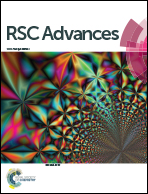Structure and electrical properties of Bi1/2Na1/2TiO3-based lead-free piezoelectric ceramics
Abstract
Lead-free piezoelectric ceramics (1 − x)(0.935Bi1/2Na1/2TiO3–0.065BaTiO3)–xAl6Bi2O12 (BNT–BT6.5–xAB, with x = 0–0.020) were prepared using a conventional solid-state reaction method and the crystal structure and electrical properties were systematically investigated. For all BNT–BT6.5–xAB ceramics form the pure perovskite phase structure, SEM-analysis revealed an increase first and then a decrease in the grain size with increasing AB content with no obvious change in grain morphology. Appropriate AB doping into BNT–BT6.5 ceramics induces the enhancement of piezoelectric and ferroelectric properties. Improved Pr = 32.8 μC cm−2, low Ec of 18.2 kV cm−1, and high d33 = 234 pC N−1 were observed at x = 0.005. Furthermore, electric field-induced strain was enhanced to its maximum value (Smax = 0.33%) with normalized strain (d33* = Smax/Emax = 413 pm V−1) at an applied electric field of 80 kV cm−1 for x = 0.010. The enhanced strain can be attributed to the coexistence of ferroelectric and relaxor ferroelectric phases. It is obvious that this piezoceramic is promising candidate for lead-free piezoceramics and can be used in practical applications.


 Please wait while we load your content...
Please wait while we load your content...